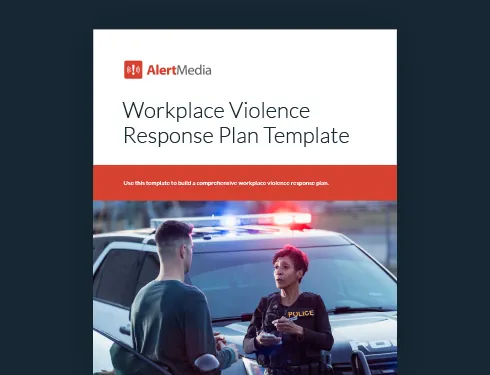
Workplace Violence Prevention in Action—Q&A With an Expert
Matt Doherty, Managing Director of Workforce Risk Management at Sikich, shares his expertise in creating workplace violence prevention programs for any business.

Targeted workplace violence is rarely an impulsive act. There are warning signs and methods you can employ to stop acts of workplace violence before they occur.
Matt Doherty is Managing Director of Workforce Risk Management at Sikich. Matt brings extensive experience gained in five decades of distinguished service helping organizations build and expand violence prevention programs; assess and manage violence risks; train and empower workforces; and gain the business benefits that come with safe and supportive workplaces. He retired from a 21-year career with the United States Secret Service as the U.S. Secret Service Special Agent in Charge of the National Threat Assessment Center. Matt recently joined The Employee Safety Podcast to discuss how organizations can develop training programs to help employees recognize the indicators of violence.
You can listen to the episode on Apple Podcasts, Spotify, or below.
Download Our Workplace Violence Response Plan Template
Q&A With Matt Doherty, Managing Director of Workforce Risk Management at Sikich
Is it common for organizations to focus on incident response instead of prevention?
Absolutely. Many organizations are only prepared to react after an incident happens. But what if they could prevent incidents from happening in the first place? What we stress in our work is early prevention before concerning actions escalate into violent actions.
Do you find that most organizations are fairly mature and you’re just smoothing out the edges, or do people have a long way to go to improve what they’re doing?
I think it runs the gamut; we’ve had Fortune 500 companies with robust programs that we applaud. Part of our work is to review those programs to help them enhance their workplace violence prevention procedures and training across the workforce. On the other hand, you’d be surprised that some large and well-known organizations have a long way to go. We help these companies develop a prevention program to align workplace violence prevention principles, communicate leadership support, and create or modify their policies and procedures—and then we create and deliver customized training.
For example, in many companies, we’ve noticed the term “zero tolerance” in the employee handbook or code of ethics. That one phrase states that workplace violence won’t be tolerated. We understand and agree that an organization has zero tolerance if there is a direct threat against an employee or a physical fight in the lobby. However, while that may be the right policy for escalated situations, a zero-tolerance policy is too punitive for many other issues in workplace violence prevention.
If an employee exhibits concerning behavior due to an untreated mental health issue, for example, we counsel our clients to direct that person to the organization’s Employee Assistance Program (EAP) to get the help they need. If another employee is the victim of domestic abuse and distracted at work—should that employee lose their job because violence may be following them to the workplace? Of course not. That person’s manager and HR should quietly support that employee and help them find the resources they need to feel safe at the workplace. We’ve found over and over that modifying a strict zero-tolerance policy to have exceptions is a best practice in an effective workplace violence prevention program.
Can you give us an example of what prevention looks like in action?
Domestic violence is a huge issue for us. Almost 40% of women killed in the workplace are killed by an intimate partner—domestic violence is an epidemic in and of itself. A good example of violence prevention is looking at whether an organization has a policy to protect employees who have a protective order or restraining order against an intimate partner. The best-practice policy is to ask employees to voluntarily provide HR with the protective order and possibly a photo of the perpetrator. This would be communicated discreetly and confidentially. Then, if a person matching that photo showed up at the workplace, the receptionist or security guard at public access points would be advised to call for help. Many times, the employee with the protective order may even be issued a parking space closer to the building for added security because parking lots, entry and exit points are vulnerable locations.
Often a restraining or protective order was originally obtained at the employee’s home, which may be in a different county. We suggest expanding that protective order to the workplace and liaising with local law enforcement to let them know about the order. I can’t tell you the number of times we’ve discovered that a company was unaware of protective orders—when they really could take some positive, proactive violence prevention steps.
What do you do to help organizations train their people to be okay with speaking up?
That question is spot on. One reason employees don’t report concerning behavior is because of the punitive nature of policies stating that workplace violence won’t be tolerated. People don’t want to throw their coworkers under the bus. One solution is for leadership to emphasize to employees the nonpunitive nature of reporting; their workplace violence prevention program is not there to get somebody in trouble. It’s there to ensure the safety of the workplace and provide support and resources for employees who may be struggling.
What can an organization do to plan and collaborate with law enforcement or other public assistance agencies?
That relationship should be established well in advance of an emergency. Law enforcement has shifted dramatically in how they handle potential risks in the workplace. If I called law enforcement 15 to 20 years ago about a concerning termination case, chances are they would not get involved, saying, “We’re not involved in HR matters. Call us when a crime has been committed, and we’ll respond to it.”
But today, active shooter incidents have made law enforcement realize that the perpetrator had exhibited concerning behavior in advance of the attack. Police have learned that they’d much rather respond to requests for early intervention rather than after a violent incident occurs. So, in a concerning termination case, for example, HR would have law enforcement either on standby or a phone call away and fully aware of the situation that’s going on.
Can you talk more about your approach to training when you work with organizations?
We bucket our workplace violence prevention training into three principal audiences: the entire workforce, people leaders, and the threat management team. And we develop different training to be suitable for each.
Foundational training for the entire workforce
“Violence can happen anywhere, especially with domestic violence situations and untreated mental health issues. Educating others about workplace violence prevention and putting these critical programs together for organizations serves the greater good.”Matt Doherty Managing Director of Workforce Risk Management at Sikich
Since the workplace violence prevention program is the responsibility of everyone in the company, every employee and leader should receive this foundational training to learn the basics of the program. We cover how to recognize warning signs and red-flag behaviors, how to report concerns, and employer and employee responsibilities.
Training for people leaders
The second bucket of training would be for people leaders. These people are your front line for prevention. We brief them on the importance of building trust with employees and spend a lot of time exploring how to manage difficult situations like concerning terminations, domestic abuse, and suicidal ideation. We also cover de-escalation principles and conflict resolution.
Training for the threat management team
Finally, it’s essential the organization creates a multidisciplinary threat management team. Many organizations call it a “safe team” or a “care team” to communicate the team’s purpose more clearly to the workforce. This team is composed of multidisciplinary members of security, HR, legal, and other members as needed—such as employee health and safety. Ad hoc members are also part of the team as needed, including EAP and perhaps local police, as well as the manager most familiar with the situation. We train this team on principles of behavioral assessment, early intervention, threat factors and mitigating factors, and threat assessment and case management.
As you look back on your career, what are you most proud of?
My work feels like a public service. Violence can happen anywhere, especially with domestic violence situations and untreated mental health issues. Educating others about workplace violence prevention and putting these critical programs together for organizations serves the greater good. The work and the support we provide fill me with pride.





